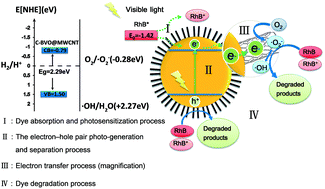Synthesis of carbon-doped BiVO4@multi-walled carbon nanotubes with high visible-light absorption behavior, and evaluation of their photocatalytic properties
Abstract
In order to realize high efficiency visible-light absorption and electron–hole separation of bismuth vanadate (BVO), we synthesized carbon-doped BVO (C-BVO) with high visible-light absorption behavior. We used polyvinylpyrrolidone K-30 as a template and L-cysteine as the carbon source in a one-step hydrothermal synthesis method, and then obtained the carbon-doped BVO@multi-walled carbon nanotubes (C-BVO@MWCNT) by a two-step method. The carbon nanotubes were characterized by X-ray diffraction (XRD), Raman spectroscopy, X-ray photoelectron spectroscopy, UV-vis diffuse reflectance spectroscopy, specific surface area, electron spin resonance, and transient photocurrent responses. The XRD analysis confirmed that all photocatalysts were in the same crystal form with a single monoclinic scheelite structure. Combining this with the other characterization results, we showed that the carbon element was successfully doped in BVO and the resulting C-BVO was successfully coupled with multi-walled carbon nanotubes. The removal ratio of rhodamine B by C-BVO@MWCNT was much higher than those by BVO and C-BVO under visible-light irradiation. Recycling experiments verified the stability of C-BVO@MWCNT, which was proved to offer excellent adsorption, strong visible-light absorption behavior, and high electron–hole separation efficiency. Such properties are expected to be useful in practical applications.



 Please wait while we load your content...
Please wait while we load your content...